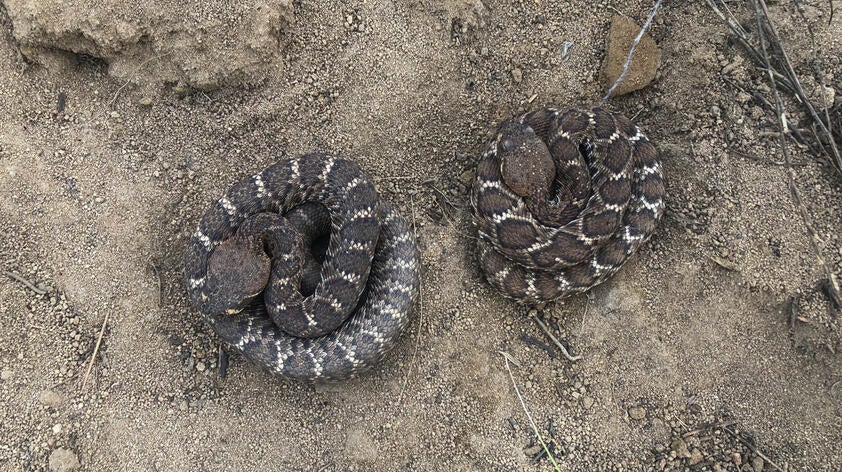
Rummaging for red-diamond rookeries
Rattlesnakes are great mothers. After giving birth, females of many species protect their young until the neonates complete their first skin shed, which may take up to 10 days or more. In San Diego our rattlesnakes primarily breed in the spring, giving birth to fully functional, venomous young from late August to early October. Observations of newborn rattlesnakes with their mothers are common in the literature for many species. In three of our four rattlesnake species (southern Pacific, southwestern speckled, and Colorado desert sidewinder), there have been many observations of neonates with their mothers, and I am happy to have observed this behavior in the wild myself. However, for our fourth and largest rattlesnake, the red-diamond rattlesnake (Crotalus ruber), observing a neonate is rare and observing a neonate with its mother is practically unheard of.
We have studied red-diamond rattlesnakes for many years in the Safari Park Biodiversity Reserve (SPBR), the 800-acre wildlands surrounding the Safari Park. Our more recent studies are focusing on the ecology and genetics of red-diamond rattlesnakes and their overwintering sites. Red-diamond rattlesnakes typically use the same overwintering sites (often called dens) every year, as do many other species of rattlesnakes. Many rattlesnakes from colder climates often give birth in dens, but this is not true of red-diamond rattlesnakes. The more we can learn about the ecology of these snakes, the more we can do to help protect them and their habitats. So naturally, it is very important to know where females give birth to their young. For the past month I have been searching the SPBR for red-diamond rattlesnake mothers with young and so far, I have not found them. So where are they?
In January, I was able to see two young snakes (estimated at 3-4 months old) together, but this is long after they were with their mother. Back in 2000, while radio tracking red-diamond rattlesnakes in the SPBR, we found that one of our female snakes went to a fairly unused area of her home range and did not move for many weeks, staying hidden under a large boulder surrounded by brush. We later found four neonate sheds at the mouth of a burrow under the boulder, after the mother had left.
To date, this is the only known evidence of red-diamond rattlesnake maternal care that we have observed or heard of. Other colleagues that study red-diamond rattlesnakes and even Laurence Klauber, the famed San Diego Zoo herpetologist and author of Rattlesnakes: Their Habits, Life Histories, and Influence on Mankind, have stated that it is very rare to see neonate red-diamond rattlesnakes, particularly in coastal habitats. Klauber even mentions in his book (first published in 1956) that observations or neonate red-diamond rattlesnakes are rare in the wild, and that he typically sees ten times the number of neonate southern Pacific rattlesnakes as he does for red-diamonds. It may take radio telemetry to figure out the all-important neonate question, but until then, I will keep on hiking!













